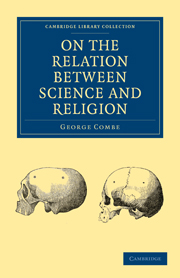Book contents
- Frontmatter
- Contents
- ADVERTISEMENT
- INTRODUCTION
- CHAP. I On the present state of the relation between Science and Religion
- CHAP. II Definition of the words Science and Religion, and Elucidation of the complex character of Religion
- CHAP. III Of Man
- CHAP. IV Of the extent to which Man is able to discover the Ultimate Elements or Essence of the External World
- CHAP. V Of God
- CHAP. VI Can we trace Divine Government in the Phenomena of the Physical and Moral Worlds? And if so, by what means is it maintained and rendered efficient?
- CHAP. VII Historical Evidence that the Divine Government of Nations is Moral
- CHAP. VIII Is this World, such as it now exists, an Institution?—Or is it the Wreck of a better System?
- CHAP. IX Practical Considerations
- CHAP. X Conclusion
- APPENDIX
- Frontmatter
- Contents
- ADVERTISEMENT
- INTRODUCTION
- CHAP. I On the present state of the relation between Science and Religion
- CHAP. II Definition of the words Science and Religion, and Elucidation of the complex character of Religion
- CHAP. III Of Man
- CHAP. IV Of the extent to which Man is able to discover the Ultimate Elements or Essence of the External World
- CHAP. V Of God
- CHAP. VI Can we trace Divine Government in the Phenomena of the Physical and Moral Worlds? And if so, by what means is it maintained and rendered efficient?
- CHAP. VII Historical Evidence that the Divine Government of Nations is Moral
- CHAP. VIII Is this World, such as it now exists, an Institution?—Or is it the Wreck of a better System?
- CHAP. IX Practical Considerations
- CHAP. X Conclusion
- APPENDIX
Summary
OF THE PHYSICAL ELEMENTS OF MAN
The human body is an organised compound substance, but its known elements belong to the inorganic kingdom. All its parts are formed from the blood, and the blood consists of two ingredients—fibrine and serum. Fibrine is identical in its composition with muscular fibre, and serum with white of egg. These two substances contain ten chemical elements: namely, oxygen, hydrogen, nitrogen, carbon, phosphorous, sulphur, chlorine, potash, soda, and lime. Iron and certain fatty substances also are found in the blood.
At present, the primitive organic form is considered to be a cell. The tissues which enter into the structure of complex organs are regarded only as the means for supplying the conditions requisite for the vital operations of the cells. Different cells have different properties; one set of cells, for example, separates certain elements from the blood and forms bones, another set forms nerves. The cause of the formation of the cell, and of different cells possessing different properties, is unknown. Many physiologists name it the vital force, and regard it as the source of growth and reproduction. Several of the conditions under which cells develope themselves into complex organs are known; but it is unascertained whether their evolutions are the result merely of properties possessed by matter in its inorganic form, or of matter and some new force added to it.
- Type
- Chapter
- Information
- On the Relation Between Science and Religion , pp. 23 - 50Publisher: Cambridge University PressPrint publication year: 2009First published in: 1857

